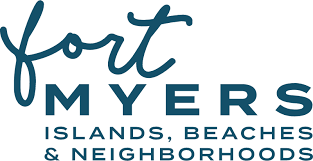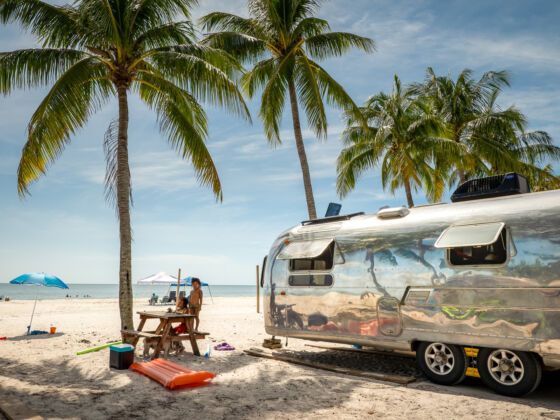Bring the kids: Outdoor adventure for the whole family on The Beaches of Fort Myers & Sanibel
We all have different feelings about traveling right now. When you’re ready, we hope you feel safe, inspired, and excited to explore The Beaches of Fort Myers & Sanibel.
Most of us associate Southwest Florida with warm sand and even warmer sunshine. It’s not a bad reputation to have — but it’s also not the whole picture. The region’s habitats vary widely from open Gulf waters to thick mangrove mazes and cypress sloughs, from remote barrier islands to wild, densely canopied rivers. For a memorable dive into nature, it’s hard to beat this part of the Sunshine State. But where do you go for COVID-friendly adventure for the whole family?
You’ll find the answer somewhere on The Beaches of Fort Myers & Sanibel. Here, outdoor adventure means slipping your kayak into gentle, back bay waters. It means staying very, very quiet while you count roseate spoonbills or gasp silently at playful manatees. It means jumping for joy when you find a rare conch shell or nail your first flyboarding spin.
If this sounds like your speed, pack up the Airstream and pack up the kids — they won’t want to miss out on anything you find in Fort Myers & Sanibel.

Note: Some of the sites and businesses listed below may not currently be operating as described due to safety guidelines. Please contact all locations prior to visiting.
There are times when getting out on the water means a quiet sail toward the sunset; there are other times when “on the water” means zooming across, flying along, or flipping above. A beach vacation doesn’t have to be low-adrenaline, especially not here in Southwest Florida — tell the kids to get ready to try flyboarding, jet skiing, and parasailing. Just to name a few.
Outfitters across the region will get you zooming, jumping, flying, and surfing — even first-timers. YOLO Watersports can hook you and the fam up on Captiva Island, while All Water Excursions is waiting for you in Bonita Springs. Ace Performer is based out of Fort Myers, and FMB FlyBoard can be found right on Hurricane Pass.
Tip: For something totally different, you can wakeboard, kneeboard, ski, or wakeskate — at up to 19mph — on one of Revolution Cable Park’s five cable-lined towers and runs, located in North Fort Myers.
There’s no reason your family explorations have to be confined to land. Enter the Great Calusa Blueway, 190 miles of marked kayak, stand-up paddleboard, and canoe trails along three rivers (and their tributaries), through Estero Bay, Pine Island Sound, and around countless coastal islands. But don’t think of it like a hiking trail — it’s more of a choose-your-own-adventure maze through Florida’s best Gulf, river, and back bay waters.
And you don’t even have to haul your own gear: Plenty of local outfitters, like Gulf Coast Kayak in Matlacha and Adventure Sea Kayak on Captiva Island, deliver to local vacation rentals or the nearest boat ramp or beach. Tackle a section and SUP the canals of Cape Coral, paddle to Buck Key from Captiva Island, or uncover the namesake of this waterway by exploring the waters around Mound Key Archaeological State Park, once home to the Indigenous Calusa. Be prepared, wherever you are, to spot dolphins, manatees, eagles, roseate spoonbills, herons, osprey, ibis, and egrets.
Note: The waterway averages four feet in depth. If you or the kids are new to paddling, this is a great place to start.
Searching for seashells (“shelling”) is an art, a sport, and a local tradition in this part of the world. The devoted rise early and master the “Sanibel Stoop” or the “Captiva Crouch” as they bend down to investigate, monitor the weather (storms churn up fresh finds), and book private charters to remote locations. But even the casual sheller — with eyes peeled — will run across the most beautiful shells they’ve ever seen, from lightning whelks to lettered olives, coquinas, and fighting conchs. If you’re looking for the proverbial jackpot, though, that’s the brown-speckled Junonia, the rarest of them all.
Almost any coastal spot in Fort Myers & Sanibel is a good one, though some will keep you stooping longer than others. For a shortlist of destinations to scope out, consider Bowman’s Beach, Blind Pass, Little Hickory Island Park, or — though it’s only accessible by boat — the remote Cayo Costa State Park.
Tip: On rainy days, head to the newly expanded Bailey-Matthews National Shell Museum, the country’s best, for a deep dive into the importance of shells. Expect engaging edutainment, art, and family-friendly activities.
Thousands of years ago, the Calusa fished these Gulf and bay waters as a primary source of sustenance. Hundreds of years ago, Cuban fishermen set up ranchos, little seasonal fishing villages, along the coast. In the 1950s, “pink gold” — the most delectable shrimp — began to be harvested just offshore. Southwest Florida’s fishing history is long, complex, and still being written today.
To take part in this longstanding tradition, simply toss in a line from the Fort Myers Beach or Bokeelia fishing piers. For something with a stronger sense of adventure, grab the fam and get out on a charter from Matlacha — the Matlacha Bridge is known as the “Fishingest Bridge in the World” — and explore the back bay and mangrove estuaries for snook, redfish, and spotted seatrout.
But when you catch something, do you just toss ‘er back in? Not necessarily — depending on what you’ve landed, restaurants like Lazy Flamingo and Pinchers will fillet and cook up your haul for you. (They can also simply bring you their catch and let you focus on the feasting.)
Thousand-pound manatees. Elegant roseate spoonbills (not, as you might think at first sight, flamingos). Atlantic and coastal bottlenose dolphins. Pelicans, cormorants, egrets, and herons. Gopher tortoises, loggerhead turtles, eastern indigo snakes, mangrove fox squirrels, and bobcats. Southwest Florida only gets wilder the more you explore.
The best-known wildlife spot around is perhaps the J.N. “Ding” Darling National Wildlife Refuge, a 6,400-acre tract of footpaths, water-based trails, and a four-mile scenic drive that ventures along the northeast side of Sanibel Island through mangrove swamps and fields of palm. The wildlife you’re likely coming for — most of the above list — will be most active closest to sunrise, sunset, and at low tide, so plan accordingly.
The mile-long boardwalk at Six Mile Cypress Slough Preserve is a great family-friendly option for total immersion into nature. There’s also Corkscrew Swamp Sanctuary, the largest virgin bald cypress forest in the country, replete with thousands of wading and migratory birds — it’s owned and operated by the National Audubon Society.
Note: For surefire dolphin sightings, go on an Estero Bay eco-tour with Fish Tale Marina; for likely manatee sightings, pay a visit to Manatee Park during the cooler winter months.
Camping has made a serious comeback in 2020, and it may be here to stay. After all, once you experience campfires on the shore or sleeping underneath a canopy of palm trees, gazing at the stars between the fronds, why would you want to do anything else?
There are numerous spots across Southwest Florida that serve as fuel for any growing camping addiction. Cayo Costa State Park, for example, is one of the largest, most remote barrier islands in the state: Its nine miles of beaches are only accessible by boat or kayak. Book a cabin or campsite to experience Florida at its wildest come nightfall — a starry experience unlike any on the mainland, no telescope required.
Koreshan State Park is another great camping option, where you’ll unpack the Airstream on the historic site of a bygone religious community along the verdant banks of the Estero River. Caloosahatchee Regional Park offers a similar experience along the wild uplands and banks of its namesake waterway. And Red Coconut RV Park is set right next to the sand of Fort Myers Beach, providing the sounds of actual crashing waves to sleep to, no sound machine required.
You could, if you wanted, vacation in Fort Myers & Sanibel, never cook a meal, and yet never go to a typical restaurant — Southwest Florida abounds in local farms and farm-to-table experiences.
Buckingham Farms’ 85-acre hydroponic operation supplies all the freshest ingredients used in their adjacent restaurant for breakfast, lunch, and dinner. Southern Fresh Farms has an onsite produce market, a Friday-night food truck and brewery, and even barnyard animals for the little ones to meet. ECHO Global Farm, meanwhile, invites visitors to volunteer on a local farm dedicated to fighting hunger, or you can simply take a tour — both are incredible educational opportunities for you and the kids (note: ECHO doesn’t offer dining service).
The farmers markets on Sanibel Island and in downtown Fort Myers are also worth a mention here, offering everything from the standard garden produce and fresh-cut flowers to French pastries, Mediterranean goodies, Argentinian empanadas, and German brats. Come early — close to 8AM — for the freshest fare.

